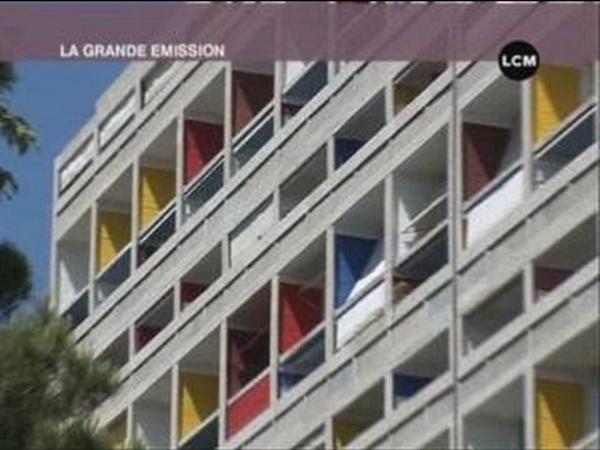



le corbusier: structure d'un appart le corbusier:structure à tiroir Le Corbusier expose son plan d'urbanisme pour Paris le corbusier Modulor Untié d'Habitation. Appartements le Corbusier réalisés à l'échelle du "modulor". La visite de ce bâtiment n’est possible qu’avec un guide. Parmi les 5 Unités d’Habitation bâties dans le monde (Marseille, Rezé les Nantes, Briey-en-Fôret, Berlin Est), celle de Firminy est la dernière édifiée. Elle est le fruit d’un second plan d’urbanisme pensé par l’architecte et Eugène Claudius-Petit. Ce plan, qui prévoyait la construction de 3 Unités, ne sera jamais totalement achevé. Commencé en 1965, le bâtiment est achevé par André Wogenscky. Il correspond au concept des "cités jardin verticales" et de la "Chartreuse moderne". L'ensemble est réalisé à l'échelle du "Modulor". Un programme de restauration et de réhabilitation a permis notamment la réouverture du tiers Nord, fermé pendant 20 ans. Seuls les pilotis, façades, école et toit terrasse sont classés au titre des Monuments Historiques en 1993.
Le Corbusier: le MODULOR Rêves d’architectes (3/3) : Chandigarh par Le Corbusier Ville nouvelle sortie de terre dans les années 50, Chandigarch respire encore l'air du Corbusier, son concepteur. Même si le temps a fait son travail de sape. « Corbusier was right ! » Dans son bureau de l'université, le Pr Rajiv Lochan rit dans sa grosse moustache. « Votre grand architecte n'avait rien compris à l'Inde. Il a créé une fiction, un rêve de ville, une construction très intellectuelle... qui, bizarrement, fonctionne. “Corbusier was a socialist ” Déjà, il y a le cadre. En 1950, quand les émissaires du Premier ministre indien Nehru débarquent à l'agence parisienne de Le Corbusier avec cette commande improbable d'une ville nouvelle pour un pays neuf à 6 000 kilomètres de chez lui, l'architecte les éconduit. Frappe d'abord à Chandigarh le système de voiries, très hiérarchisé, en sept niveaux de circulation. La ville est un corps « La négligence de mes compatriotes me laisse sans voix », murmure Manmohan Sharma, 90 ans, ancien architecte en chef de la ville.
Cité radieuse de Marseille Un article de Wikipédia, l'encyclopédie libre. Réalisation[modifier | modifier le code] Pour la réalisation de cet immeuble de grande hauteur (IGH), Le Corbusier crée l'Atelier des Bâtisseurs (AtBat), qui regroupe des architectes et des ingénieurs, dirigé par l'ingénieur d'origine russe Vladimir Bodiansky. Les architectes André Wogenscky, Georges Candilis et Jacques Masson collaborent au chantier au sein de cette structure. Un grave incendie a eu lieu à la Cité Radieuse le 9 février 2012[8][9],[10]. Histoire[modifier | modifier le code] Sortie de la Seconde Guerre mondiale, la France a besoin de se reconstruire. La Cité radieuse est finalement inaugurée en 1952, après cinq ans de travaux, malgré de nombreuses critiques politiques (le maire de Marseille, alors communiste[réf. nécessaire], s'oppose au gouvernement de Charles de Gaulle) et architecturales (ce « cube de béton » reste encore aujourd'hui critiqué). Principe architectural[modifier | modifier le code]
AD Classics: Ville Radieuse / Le Corbusier Ville Radieuse (The Radiant City) is an unrealized urban masterplan by Le Corbusier, first presented in 1924 and published in a book of the same name in 1933. Designed to contain effective means of transportation, as well as an abundance of green space and sunlight, Le Corbusier’s city of the future would not only provide residents with a better lifestyle, but would contribute to creating a better society. Though radical, strict and nearly totalitarian in its order, symmetry and standardization, Le Corbusier’s proposed principles had an extensive influence on modern urban planning and led to the development of new high-density housing typologies. In accordance with modernist ideals of progress (which encouraged the annihilation of tradition), The Radiant City was to emerge from a tabula rasa: it was to be built on nothing less than the grounds of demolished vernacular European cities. The housing districts would contain pre-fabricated apartment buildings, known as “Unités.”